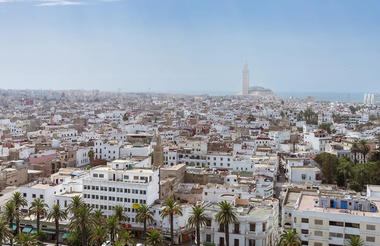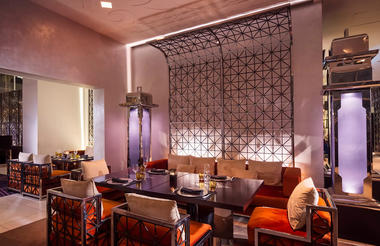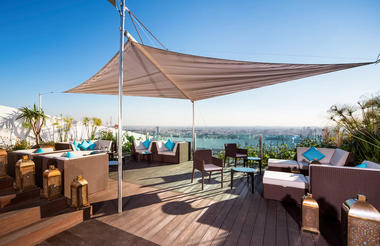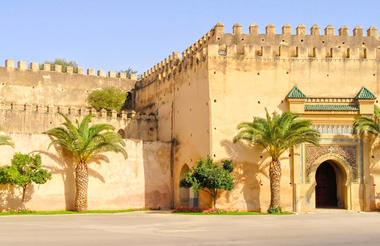Welcome to Casablanca! You will be met by an airport representative, who will assist you through immigration formalities . After you pick up your luggage, our representative will be waiting to escort you to your hotel.



Today you will enjoy a full-day excursion to discover the fascinating city of Casablanca. The name Casablanca evokes thoughts of good living, romance and adventure in a tropical setting. An image that the 1943 Humphrey Bogart film conveyed to cinema-goers in the drab years of World WarII. Casablanca's fairly recent growth has made it the bustling, French-influenced business center of Morocco it is today.
Your visit will start with the magnificent Hassan II Grand Mosque, amongst the largest in the world and can house as many as 25,000 worshipers. The mosque's minaret is the tallest religious structure in the world.
Your sightseeing will also include the Mohammed V Square, the United Nations Square and the Arab League Park. During a stroll in the Quartier Habbous you can see a modern version of a medina.



Day at your leisure to explore as you like.



Travel distance: 278 kilometers (173 miles)
Journey time: Six hours, not including stops.
Your driver will take you to Chefchaouen, a picturesque village nestled in the Rif Mountains, and well known for its blue painted walls and mesmerizing alleyways.
En route stop in Rabat for an orientation city tour.
Rabat is the capital of the Kingdom of Morocco, situated at the mouth of the River Bou Regreg, opposite the city of Sale. It boasts several historical monuments including the Hassan Tower and the gorgeous Oudaya Kasbah.
Afterwards, continue to Chefchaouen.



This morning visit the charming city of Chefchaouen (locals call Chaouen), located in the heart of the Rif Mountains.
In the 1600's, Moulay Ismail built Chefchaouen as an Arab fortress. In the centuries that followed, Chaouen saw itself transformed from a Spanish prison to what it is today. Chaouen is a great place to explore one of the country's most interesting, yet small medinas. The old city, Place Uta el Hammam, is a photographer's delight.
Enjoy your afternoon exploring as you desire, with the services of your guide and vehicle at your disposal. Have fun!



Today, continue driving to Fes. The ancient city is divided into three towns: Fes-el-Bali (old Fes), Fes-el-Jdid (new Fes), and the French-built Ville Nouvelle. The city itself is a unique historical monument with a medieval medina that has barely changed in over 500 years.



Take a step back in time to the Middle Ages with a visit to Fes El Bali, medieval medina (UNESCO ). Explore some of the 9,000 narrow lanes, alleys and souks that make up the labyrinth of the city's old quarter. Your guide will be with you to ensure that you can find your way out!
Fes was a renowned center of medieval learning and at its heart lays the Karaouine, one of the oldest, still-functioning universities in the world.
Continue on to Nejjarine Square, whose centerpiece is a beautiful fountain, made up of mosaics and elaborate tile-work. The nearby Fondouq (Caravanserai) has now been converted into a museum of carpentry artefacts.
During your visit to the tanneries, learn about the manufacturing methods used since medieval times. Enjoy browsing through the colorful displays of beautiful leather goods for sale in the markets.
After lunch, you will visit Dar Batha and the Museum of Moroccan Arts, which houses historical and artistic collections of wood carvings, embroidery, tribal carpets and ceramics.
Then, it is on to Fes El Jedid (New Fes), built by the Merinid Dynasty in the 13th century. Admire the Royal Palace, mosques, medersas (schools), souks and the city wall. Most notably, Fes El Jedid is home to the Mellah, the old Jewish quarter, which provides an interesting insight into Jewish architecture.
Last stop is a pottery factory to discover how the beautiful zellij tiles are made. These tiles are fantastic examples of Arabo-Andalusian décor and are also used in the manufacture of the famous tagines.



Depart overland to Volubilis, UNESCO World Heritage Site. With its triumphal arches, basilicas and cupolas, the Volubilis skyline is peppered with examples of Roman architecture. However, the greatest treasures of Volubilis are the superb mosaic floors, which have been excellently preserved and left in situ.
You continue on to Meknes, one of Morocco's great Imperial cities. In Meknes, the impressive monuments recall the splendor of a city first built in the 17th century by the powerful sultan Moulay Ismail to rival the court of his contemporary, Louis XIV of France.
During your visit, see the monumental Bab Mansour gateway, considered to be one of the finest gates in Morocco, as well as the Granaries and the Royal Stables, which were built to accommodate some 12,000 horses. You also have the chance to see Moulay Ismail's Mausoleum, one of the few shrines in Morocco that can be visited by non-Muslims.
Enjoy lunch in at Le Bistrot in Meknes and afterwards continue your visit of the city.
At the end of the day, transfer back to your hotel in Fes.



Travel distance: 400 kilometers (250 miles)
Journey time: Approximately seven hours, not including stops
Today, travel into the desert, passing through the impressive Atlas Mountains and discover the Tafilalet region, famous for its savory dates and gorgeous scenery.
Erfoud is a largely French-built administrative center and is known for its delightful palm dates.
Take a look at Erfoud's quarry, where fossils have been found from the sea that used to lie here. Nowadays, the mining of these fossilized rocks is a growing and popular industry in this part of Morocco and the fossilized rocks excavated here are used to produce beautiful decorative objects ranging from crockery to furniture.



Travel distance: 60 kilometers (38 miles)
Journey time: 45 minutes
Today, continue your explorations of the Tafilalet region with a visit of Rissani, the last visible point of the Ziz River and stroll through a centuries-old palm grove and meet some furry friends at the donkey parking area.
Head south travelling by four-wheel-drive vehicle along the desert dunes of Erg Chebbi to your tented campsite. Your final part of your journey to the camp will be via a most traditional mode of transport, crossing the final dunes on camelback before reaching your camp. On arrival, enjoy a reception of mint tea and pastries, followed by a sundowner drink in the dunes.
Later this evening, savor a mouth-watering dinner served around a campfire, (weather permitting) and will be complimented by traditional entertainment.
In a remote corner of the Sahara and nestled within the towering dunes, our specially-designed private mobile camp is a fantastic way to experience the serenity of the desert.



In a remote corner of the Sahara and nestled within the towering dunes, our specially-designed private mobile camp is a fantastic way to experience the serenity of the desert. The tents, which are in traditional Arabic "Caidal" style and design, are decked out with colorful carpets. Each tent comfortably sleeps two people on a double or twin basis. Additional warm bedding and hot water bottles are provided should the nights be particularly cold. Located next to each tent is a private bathroom with a shower and chemical toilet. Please be aware that there is no electrical service in the camp, so you may enjoy the quiet of the desert with an unpolluted starry sky.
Travel distance: 367 kilometers (230 miles)
Journey time: Approximately six hours, not including stops.
Today travel overland to Ouarzazate. The city . Ouarzazate was built as a French garrison in the 1920s, and was once a stopping point for African traders en route to the cities of Morocco and Europe. Today, it is a regional trade center known for pottery and carpets.
Travel through the southern slopes of the High Atlas range, following the Dades Valley and passing flourishing crops, irrigation canals and palm trees.
Along the way make a stop to visit an amazing, small private museum in a Ksar near Tingherir, which houses exhibits that showcase the local art, culture and history.
Your journey crosses the little city of Skoura, nestled in a gorgeous palm grove as you continue on to your hotel.



Travel distance: 162 kilometers (101 miles)
Travel time: Approximately three hours, not including stops.
Today, you travel by four-wheel-drive vehicle via the N9 as it plunges southeast into the Draa Valley.
Formed by a narrow ribbon of water from the High Atlas that occasionally emerges triumphantly in lush oases, particularly between Agdz and Zagora, the valley stretches for about 95km. The drive from Agdz to Zagora takes less about 1.5 hours (excluding stops), via the more scenic route off the beaten path road through the oasis.
Arrive in Zagora for a late lunch in Dar Lamane, one of the hidden gems of the city. Sip on mint tea while exploring the African Safari part of the property, then head back to your hotel in Ouarzazate.



Travel distance: 110 kilometers (67 miles)
Journey time: Approximately five hours, not including stops.
Today, travel through the stunning Atlas Mountains to reach Kasbah Tamadot. This gorgeous Richard Branson property is beautifully set in the foothills overlooking spectacular vistas, offering a blend of original features, traditional art and unique furniture, creating an opulent atmosphere.
En route, stop in the fortified village of Ait Benhaddou, the most exotic and best-preserved Kasbah in the whole of the Atlas region. The village has starred in an array of movies, such as Lawrence of Arabia, Jesus of Nazareth, Gladiator and The Mummy.
Continue by road over the Tizi n'Tichka Pass, the highest in the region at a height of 2,260 meters (7,415 feet) and stop to marvel at the panoramic views. As your journey continues, take note of the picturesque villages, passing by travelers going from one village to the next on foot or by mule. Admire the lush green eucalyptus trees, contrasting the red hue of the rocky hills. Notice the exotic smell of chwaya (grilled meat) and Berber tagines, beautifully displayed with a tomato on the top.



Kasbah Tamadot sits in an idyllic location nestled among the breathtaking High Atlas Mountains, creating an immense sense of privacy. The property is the former home of Luciano Tempo, who filled it with beautiful antiques of Arabic, Oriental and Indian origin. The Kasbah was then purchased by Sir Richard Branson in 1998 and wonderfully restored to become one of the most luxury properties in Morocco. Tamadot is full of peaceful courtyards, hidden staircases, landscaped gardens and breathtaking views. Many of the staff members come from the surrounding Berber villages, giving you a sense of staying in a Moroccan home rather than a hotel. Luxury rooms and suites are all individually-decorated using traditional Moroccan furnishings and antiques whilst the restaurant, bars and outdoor infinity pool all offer stunning panoramic views.
Today, enjoy your day as you wish at Kasbah Tamadot. The services of your guide and vehicle are at your disposal.



Today, unearth another side of Morocco, the gorgeous Atlas Mountains - North Africa's greatest mountain range - and experience two different worlds: traditional Berber and modern luxury.
Along the way, admire the stunning views of the snow-capped mountains and the little Berber villages nestled in the hills. Discover the villages of Asni and Imlil in the foothills of Djebel Toubkal, the highest mountain in the Atlas Mountain range.
Berbers are the original inhabitants of North Africa and they are composed of several tribes scattered throughout the region. Known as very proud and hard-working people, they have their own dialect, customs and traditions. During this inspiring excursion, you will have the amazing opportunity to discover a Berber way of life. Via a little road, you will reach a village located on a small hill, where Mohamed welcomes you to his family. You will meet his wife and children and learn about their habits. While visiting their humble house you will discover the traditional oven where they cook the delightful Berber bread. While savouring it with a mint tea, Mohamed, with the help of the guide, will talk to you about his family, his history and will answer any question you may have regarding Berber culture.
Afterwards, take the road to reach the thrilling and colorful city of Marrakech. Pearl of the South, Jewel of the South, The Red City - just a few of the nicknames Marrakech has acquired over the years. Part Berber, part Arab and part African, Marrakech is the heartbeat of Morocco where palaces and monuments of unrivalled refinement sit calmly alongside snake charmers and Gnaouan drums, pulsing constantly from Djemâa el Fna Square - the most exuberant marketplace in the world. The city is also home to luxury hotels, sophisticated bars and exotic restaurants.



Today, discover the Mysteries of Marrakech and the city's architectural attractions, the majority of which are located inside the Medina, the old walled section of the town.
Begin by exploring the labyrinthine souks and perhaps indulge in some shopping! Souk Smarine is an important thoroughfare, traditionally dominated by the sale of textiles, clothing and Moroccan handicrafts. This maze of colorful alleys and small squares is home to a bewildering array of stalls and ateliers devoted to specific crafts.
Next, explore Jemaa El Fna, the city's main square, which is home to a multitude of street-artists and food stalls. Over the years the square has become the beating heart of Marrakech, where fire-eaters, acrobats, snake-charmers and street musicians perform at every turn.
Continue on to the Koutoubia mosque, an emblem of Marrakech. It is not possible to enter the mosque, but its beauty can be admired from the gardens and the square. Built in the 12th century, the Koutoubia's minaret is considered to be one of the highlights of Islamic religious structures in North Africa and the inspiration for the architects of the Giralda in Seville and the Hassan Tower in Rabat. This famous landmark dominates the local skyline and can easily be spotted from all over Marrakech.
Finally, take a look at the Bahia Palace, a remarkable example of Arab-Andalusian architecture where the use of marble, stucco and mosaics is prevalent in the apartments, opening on to courtyards filled with fountains and plant life.



Today take a seat in a horse-drawn carriage for a ride through Marrakech's famous, beautiful gardens which are dotted around the city. The area is fed by a basin that is supplied with water via an old hydraulic system which conveys water from the mountains located at nearly 20 miles away.
Begin with a visit to the Menara gardens, which date back to the 12th century and are set among extensive orchards and olive groves. At the center is a rectangular pool with a fabulous view of the Atlas Mountains.
From here it's on to visit the Jardin Majorelle (Majorelle Gardens), originally designed in 1924 by French artist Jacques Majorelle. He transformed the property's existing garden into a tropical paradise, surrounded by vivid cobalt blue buildings with verdant exotic groves, lily-covered pools, and enormous sculptural cactuses.
The remainder of the day is at leisure, a perfect opportunity for some last-minute shopping or sightseeing at your own pace.
New in Marrakech is the Yves Saint Laurent Museum, where the most precious YSL works are gathered. Yves Saint Laurent and Pierre Bergé fell in love with the colors of Marrakech and therefore resided here for some of the most beautiful years of their lives.
The museum, a 43,000-square-foot building, was designed by the Paris-based firm Studio KO. Inspired by the contemporary and Moroccan architecture, you can find blues and greens on one side of the entrance hall, reds and tangerines on the other. After being carefully selected by Pierre Bergé, the museum will gather more than 5,000 dresses and 15,000 Haute Couture accessories.
In the later afternoon, we have planned a cooking workshop at La Maison Arabe. These workshops are designed for the amateur and professional alike. The workshops are conducted by a dada (traditional Moroccan chef) and assisted by a English translator.
At the end of each workshop, participants dine on the meal they have prepared. One normally learns to prepare an appetizer and a main dish commonly consisting of a Moroccan salad and a Tajine.



Today you will be transferred to the airport on time for your flight.






